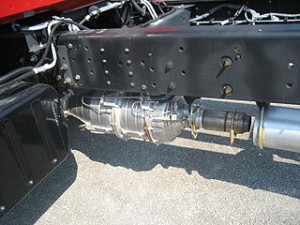On May 29, 2015, I posted: “Increased truck weights could mean less bad air, roadway damage.”
Truck-trailer size, load-carrying capacity and what the impact is on roadway infrastructure is but the half of it. The other half, of course, has to do with the amount of freight shipped, what mode is responsible for moving what amount and truck mileage efficiencies, exactly what is being considered today.
“The decentralization of production makes truck transportation cost-effective and less reliant on centralized facilities such as ports and freight terminals. In other words, we should expect to see a world with many more trucks in the future than the number we have today,” Steven Cohen in the Huffington Post article: “Sustainable Shipping and EPA’s Truck Mileage Standards” surmised.
This was preceded by Cohen in the article in question pointing out how in the U.S. trucks move around 70 percent of the country’s freight. Is he correct? If so, that would mean the remainder (approximately 30 percent) is divided among trains, boats, planes, pipelines, etc.
To gain more perspective, “Table 2.1. Weight of Shipments by Transportation Mode: 2007, 2012, and 2040,” of the “Freight Facts and Figures 2013” document from the U.S. Department of Transportation/Federal Highway Administration and U.S. Department of Transportation/Bureau of Transportation Statistics (DOT/FHWA and DOT/BTS), was consulted.
Domestically, in 2012, total freight weight moved was 19.662 billion tons, trucks moving 13.182 billion tons with trains handling 1.855 billion tons. Meanwhile in 2007, the total amount shipped was 18.879 billion tons, the truck and train share being 12.778 billion tons and 1.9 billion tons, respectively.
Here are the projections for 2040: 18.786 billion truck-freight tons; 2.77 billion train-freight tons; etc., for a total projected tonnage shipped of 28.52 billion tons. In the U.S. anyway, if that comes to pass, based on weight, truck shipping, according to this projection, will account for nearly 66 percent of the freight. Rounding out the list besides rail and truck are: water; air, air & truck; multiple modes & mail; pipeline; other & unknown.

If both Cohen and the DOT/FHWA and DOT/BTS are correct in their projections, estimates, call them what you will, then it is probably safe to assume that the amount of worldwide truck emissions will rise considerably unless there are across-the-board and effective mitigation measures put into effect to significantly reduce those emissions.
Related to this, in what appears to be a heads-up, New York Times writers Aaron M. Kessler and Coral Davenport, in the third paragraph in their article “E.P.A. Proposal Will Put Bigger Trucks on a Fuel Diet,” in effect, point out that the U.S. Environmental Protection Agency (EPA) this week is going to propose rules to increase diesel truck fuel economy ratings from a current average 5 or 6 miles per gallon to as high as 9 miles to the gallon on average, no doubt part of a bigger move to improve the fuel-efficiency ratings of motor vehicles on America’s roads and to help clean the air.
Automobile fuel economy by 2025 will need to be essentially double what it is now – an average 54.5 mpg. But, a fuel-economy improvement for trucks (up 40 percent from 2010 base year figures) by 2027, will not be inexpensive, Kessler and Davenport observed, and could add anywhere from $12,000 to $14,000 more to what it will cost to manufacture a new truck. Based on EPA studies, according to the Times writers, estimates are that the additional expense will be recovered in a year-and-a-half’s time based on the amount of fuel purchased, which, will, of course, be less.
Cohen, meanwhile, insists “… an effort must be made to make the shipping system as efficient as possible and work to reduce its inevitable impact on ecosystems and environmental quality.”
Image above: Dana60Cummins
– Alan Kandel